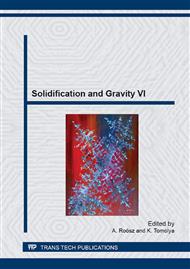[1]
Kurella, N.B. Dahotre, , "Laser Induced Hierarchical Calcium Phosphate Structures, Acta Biomaterialia 2 (2006) 677-688.
DOI: 10.1016/j.actbio.2006.05.001
Google Scholar
[2]
T. Kokubo, H.M. Kim, M. Kawashita, Novel bioactive materials with different mechanical properties, Biomaterials 24 (2003) 2161–2175.
DOI: 10.1016/s0142-9612(03)00044-9
Google Scholar
[3]
M. Sumita, T. Hanawa, S.H. Teoh, Development of nitrogen-containing nickel-free austenitic stainless steels for metallic biomaterials, Materials Science and Engineering: C 24 (2004) 753-760.
DOI: 10.1016/j.msec.2004.08.030
Google Scholar
[4]
Lucas LC, Dale P, Buchanan R, Goll Y, Griffin D, Lemons JE., In vitro vs. in vivo corrosion analyses of two alloys. J Invest Surg. 4(1) (1991) 13–21.
DOI: 10.3109/08941939109140757
Google Scholar
[5]
Geis-Gerstorfer J, Sauer KH, Passler K., Ion release from Ni–Cr–Mo and Co–Cr–Mo casting alloys, Int J Prosthodont 4(2) (1991) 152–8.
Google Scholar
[6]
Grimido NJ., Biocompatibility of nickel and cobalt dental alloys, Gen. Dent. 49(5) (2001) 498–503.
Google Scholar
[7]
Dong H, Nagamatsu Y, Chen KK, Tajima K, Kakigawa H, Shi S, Kozono Y. , Corrosion behavior of dental alloys in various types of electrolyzed water, Dent. Mater. J. 22(4) (2003) 482–93.
DOI: 10.4012/dmj.22.482
Google Scholar
[8]
A.G. Cobb, T.P. Schmalzreid, The clinical significance of metal ion release from cobalt–chromium metal-on-metal hip joint arthroplasty, Proc. Inst. Mech. Eng. H. 220 (2006) 385–398.
DOI: 10.1243/09544119jeim78
Google Scholar
[9]
T. Hanawa, Metal ion release from metal implants, Mater. Sci. Eng. C. 24 (2004) 745–752.
Google Scholar
[10]
J.J. Jacobs, J.L. Gilbert, M. Calvitti, R. M. Urban, Corrosion of metal orthopaedic implants J. Bone Joint Surg. 80A (1998) 268-282.
Google Scholar
[11]
M. K. Lei, X.N. Zhu, In vitro corrosion resistance of plasma source ion nitrided austenitic stainless steels Biomaterials 2 (2001) 641-647.
DOI: 10.1016/s0142-9612(00)00226-x
Google Scholar
[12]
M. Browne, P.J. Gregson, Surface modification of titanium alloy implants, Biomaterials 15 (1994) 894–898.
DOI: 10.1016/0142-9612(94)90113-9
Google Scholar
[13]
A. Karaalia, K. Mirouh, S. Hamamda, P. Guiralden, Microstructural study of tungsten influence on Co–Cr alloys, Materials Science and Engineering A 390 (2005) 255–259.
DOI: 10.1016/j.msea.2004.08.001
Google Scholar
[14]
Viswanathan S. SAJI, Han-Cheol Choe, Electrochemical behavior of Co-Cr and Ni-Cr dental cast alloys, Trans. Nonferrous Met. Soc. china 19 (2009) 785-790.
DOI: 10.1016/s1003-6326(08)60350-7
Google Scholar
[15]
I. Peter, M. Rosso, A. Toppi, I. Dan, B. Ghiban, Investigation on Cobalt based alloy modified by Titanium for dental applications, Archives of Materials Science and Engineering 61 (2) (2013) 62-68.
Google Scholar
[17]
C.D. Wagner, W.M. Riggs, L.E. Davis, J.F. Moulder, G.E. Muilenberg, Handbook of X-ray Photoelectron Spectroscopy, Perkin-Elmer, Minneapolis, MN, 1978, p.190.
Google Scholar
[18]
C.D. Wagner, A.V. Naumkin, A. Kraut-Vass, J.W. Allison, C.J. Powell, J.R. Rumble Jr., NIST Standard Reference Database 20, Version 3. 4 (Web Version).
Google Scholar


